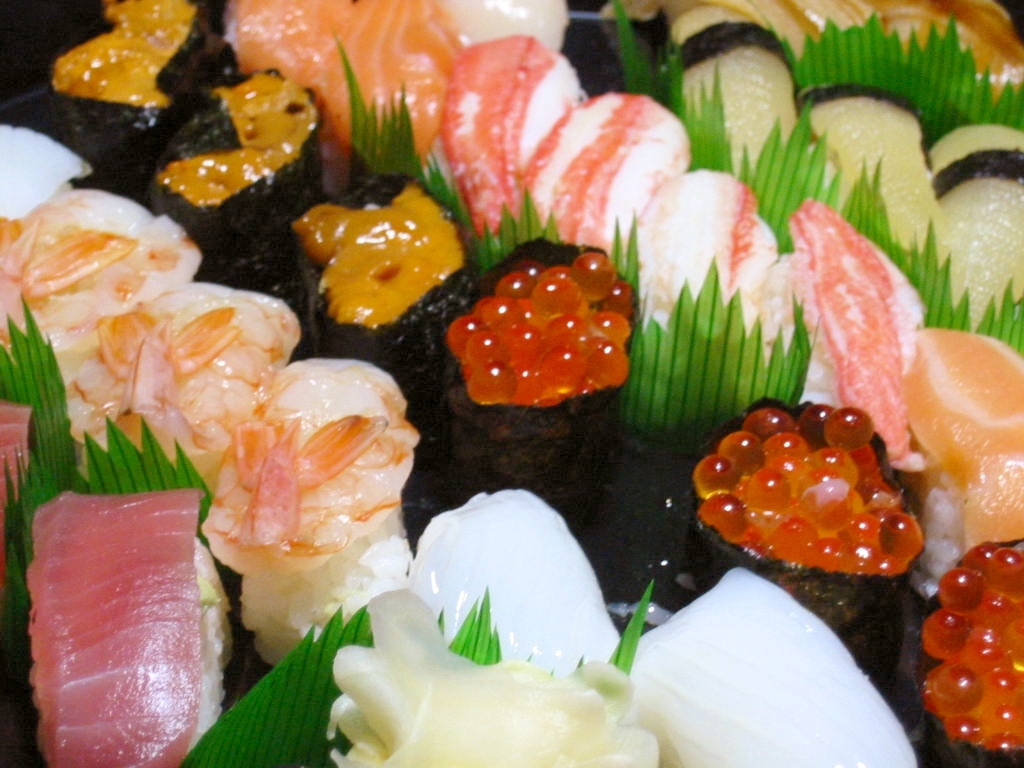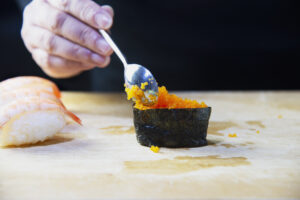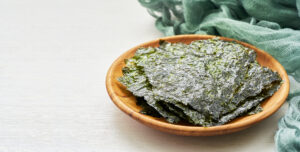Other Sushi Ingredients – Beyond Fish
Rice (米)- The Pillar of Sushi:
At the core of the sushi experience stands the indispensable element—rice, known as sumeshi, or shari once it’s been formed into blocks for nigiri or gunkanmaki. Sushi rice isn’t just any rice; it’s a specific type, the sticky Japanese short grain rice, chosen for its unique properties that contribute to the signature texture and cohesion of sushi. This particular rice variety, with its glutinous nature, allows sushi rice to cling together, supporting the various toppings and fillings with a perfect balance of firmness and tenderness.
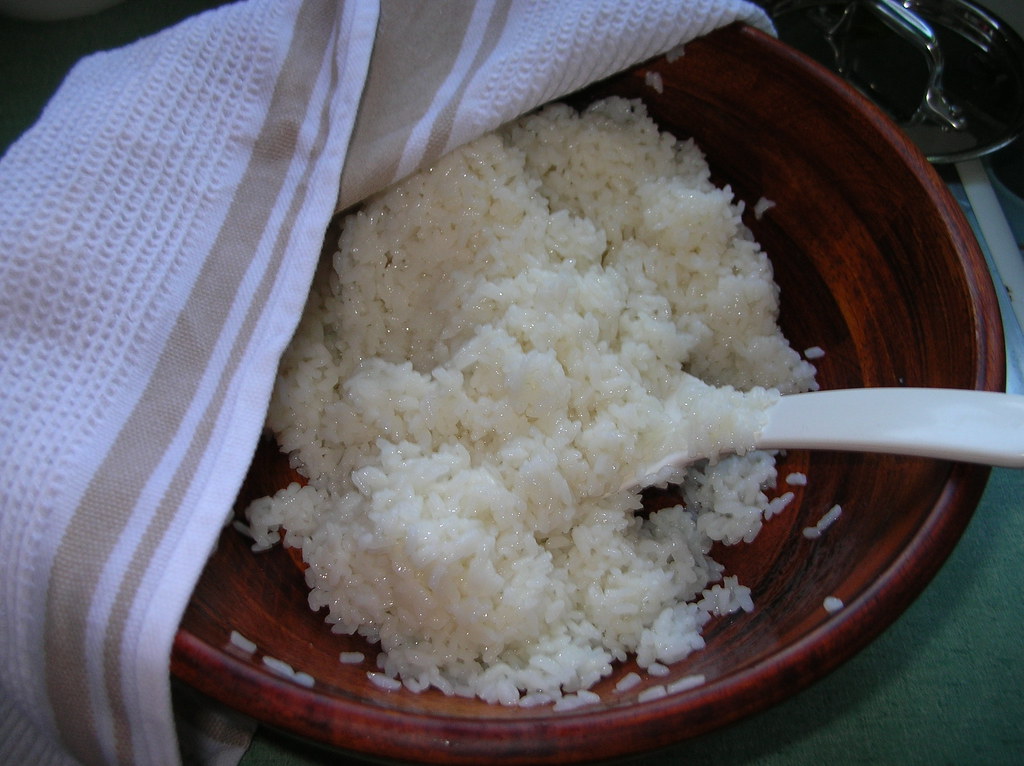
The delicate balance of vinegar and sugar infused into sumeshi plays a crucial role in shaping the character of sushi. This seasoned rice not only acts as a structural foundation but also imparts a subtle tangy sweetness that harmonizes with the raw fish, seaweed, and other ingredients, creating a complex symphony of flavors. The meticulous crafting of sumeshi requires not only the skills needed to cook perfectly textured Japanese rice, but also a keen understanding of the delicate equilibrium between vinegar and sugar, showcasing the dedication and expertise that sushi chefs bring to each preparation.
It’s essential to reiterate that sushi cannot and shouldn’t be made with just any type of rice. As mentioned, the sticky nature of Japanese short grain rice is unique in its ability to create the desired texture and adherence necessary for a superb sushi experience. Other rice varieties, such as mochi rice or Southeast Asian long grain varieties like Thai jasmine or South Asian basmati, lack the necessary stickiness to bring the diverse elements of sushi together. The choice of rice is not just a technical detail; it’s a crucial component that ensures the authenticity and integrity of each sushi creation.
In unraveling the significance of rice in sushi, one delves into the artistry that underlies this culinary tradition. Sushi rice isn’t merely a vehicle for the toppings; it’s a fundamental component that elevates the entire dining experience. The sticky Japanese short grain rice, carefully seasoned and crafted, stands as the unsung hero, binding together the diverse elements of sushi into a delectable masterpiece.
Sweet Rice Vinegar (寿司酢) – Foundation of Japanese Sushi:
At the heart of authentic Japanese sushi lies the fundamental pairing of sweet rice vinegar and rice. Initially employed as a preservation method in the absence of refrigeration, sweet rice vinegar found its way into sushi preparation, transforming into a cornerstone of this beloved culinary tradition. The delicate balance between the sweetness of the vinegar and the subtle flavor of the rice forms the foundation of Japanese sushi, creating the perfect canvas for the vibrant tapestry of sushi flavors to unfold.
Nori (海苔)– Seaweed Paper:
Nori, the versatile seaweed paper, plays a pivotal role in the visual and textural aspects of sushi. Sourced from various species of red, green, and blue-green algae, nori undergoes a meticulous manufacturing process that includes harvesting, chopping, pressing, drying and roasting. All this handling culminates in the creation of an edible seaweed paper with a distinct briny, umami essence. Beyond its structural role in wrapping rolls, nori introduces an oceanic nuance to sushi, pairing with the fish to elevate the overall sensory experience with its subtle flavors.

Gari (ガリ)– Sweet, Pickled Ginger Slices:
Gari, the quintessential accompaniment to sushi, embodies the delicate dance of sweet and tangy flavors. These pink hued ginger slices undergo a pickling process, marrying sugar and vinegar to create a palate cleansing condiment. Traditionally resets the flavor profile between different kinds of sushi, gari prepares the taste buds for the diverse flavors that characterize each sushi creation. Its sweet, spicy, and tangy profile not only rejuvenates the palate but also adds a layer of complexity to the overall sushi experience.
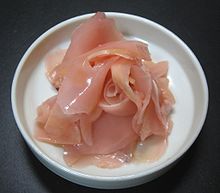
Wasabi (山葵) – The Green Japanese Horseradish:
The often misunderstood wasabi, the green hued paste that is served alongside sushi, carries a rich narrative of its own. Unveiling the truth about wasabi reveals that the pungent paste commonly encountered in overseas sushi restaurants, and even in Japan recently, is frequently a hydrated horseradish powder substitute. Crafted with horseradish that has tinted green with food coloring, this imposter is notorious for its intense spiciness, often catching diners off guard.
Real wasabi, derived from the rhizome of the Wasabia japonica plant, stands as the rare and more expensive original. Possessing a milder spiciness compared to its horseradish counterpart, authentic wasabi allows connoisseurs to appreciate the subtle complexity of its flavor profile. The scarcity of the Wasabia japonica plant, due to the very specific and limited environment and climate needed to grow it, adds an air of exclusivity to the genuine article, and offers a glimpse into the authentic and nuanced world of traditional Japanese sushi. In the intricate dance of sweet rice vinegar, nori, gari, and genuine wasabi, sushi emerges not just as a culinary delight but as a unique symphony of harmonious flavors, textures, and cultural heritage.
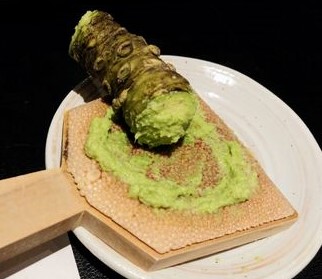
Types of Sushi Restaurants
Traditional Sushi Bars:
Sushi bars, diverse in their forms, offer patrons unique and immersive dining experiences, each contributing to the rich tapestry of sushi culture. Traditional sushi bars, with their timeless charm, create an intimate setting where chefs have the opportunity to showcase their culinary skills directly to customers.
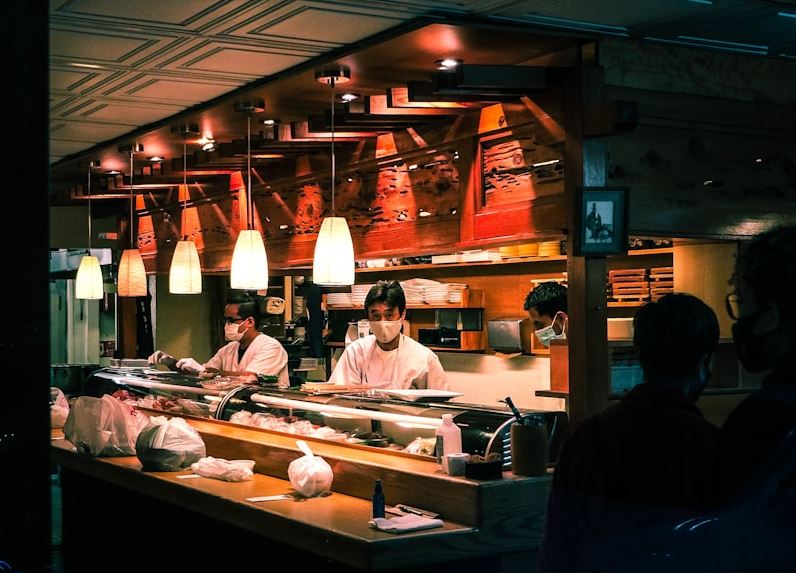
Among these traditional establishments, the iconic “Traditional Sushi Bar” stands out as a testament to the artistry of sushi preparation. The interior design of such sushi bars plays a crucial role in enhancing the overall dining experience. Traditional sushi bars often feature a light-colored wood motif, creating an atmosphere of calm and ease for customers. This deliberate choice in décor is not merely aesthetic; it is a thoughtful component woven into the fabric of the dining journey.
As customers approach the sushi bar, they are greeted by a counter adorned with a refrigerated glass case, showcasing the freshest ingredients waiting to be transformed into exquisite sushi pieces. This transparent display adds an element of transparency to the culinary process, inviting customers to witness the craftsmanship firsthand. Behind this counter, skilled chefs move with precision and grace, meticulously crafting sushi and placing each delicate piece onto individual wooden platters for customers.
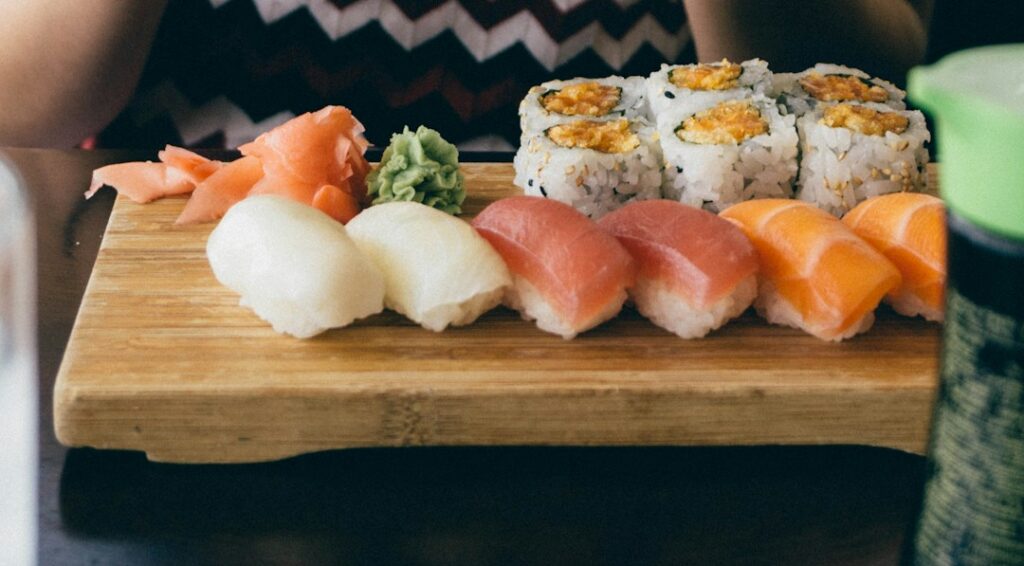
The tactile experience is emphasized in traditional sushi bars, where sushi is meant to be enjoyed with hands rather than chopsticks. This choice not only adds a layer of authenticity but also creates a direct and intimate connection between the culinary artisan and the connoisseur. The wooden boards the sushi is served on further contribute to the sensory experience, providing a natural and organic backdrop to the vibrant colors of the sushi.
In essence, the traditional sushi bar extends beyond its role as a place for culinary delights; it becomes a sanctuary where the art of sushi-making unfolds before the eyes of those who appreciate not only the flavors but also the craftsmanship. The deliberate design choices, from the light-colored wood motif to the open display of ingredients, all contribute to the creation of a space that enhances the overall enjoyment of sushi, turning it into an immersive and memorable experience for patrons.
Kaiten Sushi (回転寿司):
In contrast, the innovative “Kaiten Sushi,” also known as conveyor belt sushi, has revolutionized the traditional dining experience. This unique concept introduces a rotating belt adorned with delectable morsels of sushi. As the belt gracefully circles the restaurant, customers can choose their desired sushi creations, making the dining process both interactive and dynamic.
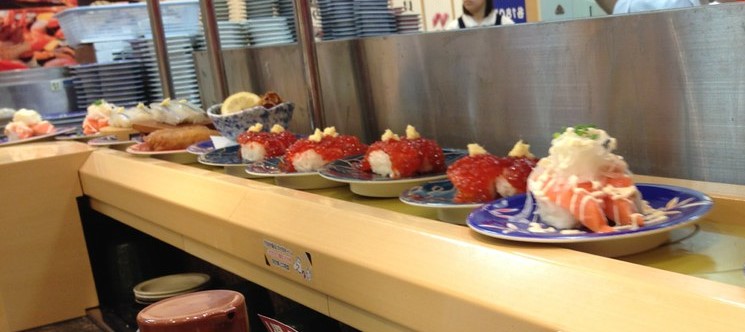
What sets Kaiten Sushi apart extends beyond its dynamic presentation. One distinctive feature is its cost effectiveness, providing an accessible entry point for sushi enthusiasts and beginners alike. In Kaiten Sushi establishments, plates are color coded to reflect different price ranges, allowing patrons to gauge costs easily. This pricing strategy not only caters to a diverse audience but also encourages experimentation, making it an ideal setting for those new to the world of sushi. The affordability and approachability of Kaiten Sushi contribute to its popularity as a go to option for those eager to explore various sushi offerings without breaking the bank.
Moreover, Kaiten Sushi establishments often serve as training grounds for aspiring sushi chefs. Beginner chefs frequently find their initial experiences in the culinary world within the dynamic and fast paced environment of Kaiten Sushi restaurants. This serves as a valuable learning ground where novice chefs hone their skills, perfecting the art of sushi preparation and customer interaction. As a result, Kaiten Sushi not only transforms the dining experience for patrons but also plays a crucial role in nurturing the next generation of sushi artisans.
The term “Kaiten Sushi” encompasses various names, such as conveyor belt sushi, rotation sushi, and revolving sushi bar, capturing the essence of this inventive dining approach. The continuous movement of the belt offers patrons a visual feast of options, allowing them to select and savor an array of sushi delights. This not only transforms the act of dining into a lively and engaging experience but also promotes a relaxed and casual atmosphere. Kaiten Sushi stands as a vibrant and inclusive culinary space, inviting patrons to explore, learn, and enjoy the art of sushi in a dynamic and accessible setting. Whether patrons prefer the traditional allure of a sushi bar or the dynamic, interactive experience of a conveyor belt sushi establishment, both settings contribute to the global fascination with sushi. These diverse culinary environments showcase the adaptability of sushi culture, catering to a wide range of preferences and culinary expectations. As sushi continues to captivate hearts worldwide, the varied forms of sushi bars remain essential conduits for cultural exchange and appreciation of this Japanese culinary art.
Empowering Home Sushi Chefs: A Rise in DIY Sushi Kits
Amid the global surge in sushi’s popularity, there has been a notable trend in enthusiasts embracing the art of sushi making at home. This shift towards DIY sushi preparation has been accompanied by the widespread availability of sushi kits, empowering home chefs to craft their sushi masterpieces.
Sushi Kits Unveiled:
Sushi kits, comprising essential ingredients like premium sushi rice, vinegar, nori sheets, and carefully curated fish selections, have become a culinary gateway for those eager to try their hand at sushi creation. These kits often include specialized tools such as roll making mats and nigiri rice presses, ensuring that aspiring chefs have everything they need for an authentic and enjoyable sushi making experience.
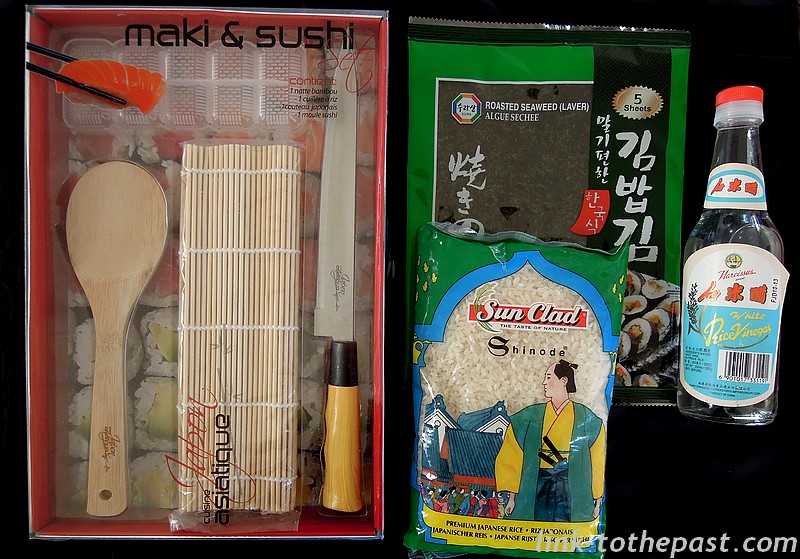
Home Sushi Revolution:
The convenience of sushi kits has contributed to a rise in home sushi making enthusiasts, fostering a deeper appreciation for the intricacies of crafting this Japanese delicacy. As more individuals embark on their sushi making journey within the comfort of their kitchens, it adds a new dimension to the global sushi experience, where creativity knows no bounds.
Beyond the Restaurant:
This phenomenon not only signifies a shift in the way people engage with sushi but also serves as a testament to the adaptability of this culinary tradition. Home sushi making reflects a broader cultural exchange, where the essence of sushi transcends restaurant walls, finding its way into the hands of individuals eager to explore and create within their own kitchens.
Sustainability in Sushi Consumption: A Closer Look at the Endangered Bluefin Tuna
As sushi enjoys a surge in global popularity, an expanding awareness of the environmental repercussions tied to its consumption has taken center stage. While the delicate balance of flavors in traditional nigiri, such as tuna, has captivated palates worldwide, the escalating demand for specific fish species, notably the Bluefin Tuna, has triggered substantial concerns surrounding overfishing and the depletion of marine resources.
The Bluefin Tuna, a prized species for sushi connoisseurs due to its rich flavor and succulent texture, faces a dire predicament. Over the years, extensive fishing efforts targeting Bluefin Tuna populations have led to a severe decline in their numbers. The insatiable appetite for Bluefin Tuna, especially in high end sushi establishments, has exacerbated the issue, pushing this majestic species to the brink of endangerment.

Environmentalists and marine conservationists have sounded the alarm, emphasizing the urgent need for sustainable sushi practices to ensure the survival of Bluefin Tuna and other vulnerable marine species. The depletion of these apex predators not only disrupts the marine ecosystem but also jeopardizes the delicate balance that sustains diverse marine life.
Initiatives advocating for sustainable sushi consumption are gaining momentum within the global sushi community. The focus is not only on choosing responsibly sourced seafood but also on addressing broader issues, such as reducing single use plastics and minimizing the carbon footprint associated with sushi production and distribution. By embracing sustainable practices, the sushi industry aims to strike a harmonious balance between satisfying culinary desires and safeguarding the delicate ecosystems that provide the raw ingredients for this beloved cuisine.
The Bluefin Tuna’s endangered status serves as a poignant reminder of the interconnectedness between culinary choices and environmental well being. As consumers, chefs, and restaurateurs become increasingly aware of the impact of their sushi preferences on marine ecosystems, a collective effort emerges to reshape the narrative surrounding sushi consumption. Through responsible choices and conscious decisions, the global sushi community can contribute to the preservation of marine biodiversity, ensuring that future generations can continue to savor the delights of this iconic Japanese culinary art form.
As the allure of sushi continues to captivate palates worldwide, the rich tapestry of this Japanese culinary art unfolds in diverse settings. From traditional sushi bars exuding timeless charm to the dynamic and accessible world of Kaiten Sushi, the global fascination with sushi showcases its adaptability. The recent surge in home sushi chefs, empowered by DIY sushi kits, adds a new dimension to the sushi experience, transcending restaurant boundaries. Yet, this journey is not without challenges, with the sustainability of sushi consumption taking center stage. The plight of the Bluefin Tuna emphasizes the need for responsible choices to preserve marine biodiversity. In navigating this delicate balance, let us savor sushi with awareness and appreciation, ensuring the legacy of this iconic cuisine endures for generations. The global sushi community, spanning traditional and contemporary realms, continues to evolve, creating a harmonious blend of tradition and innovation in every delectable bite.
